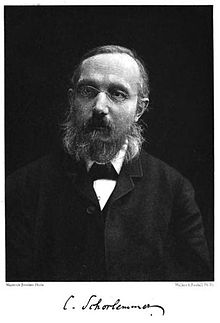Carl Schorlemmer
| Carl Schorlemmer | |
|---|---|
 |
|
| Born |
30 September 1834 Darmstadt, German Confederation |
| Died | 27 June 1892 (aged 57) Manchester, England |
| Residence | Germany, England |
| Nationality | German |
| Alma mater |
University of Heidelberg, Victoria University of Manchester, |
| Scientific career | |
| Institutions | Owens College now University of Manchester |
| Doctoral advisor |
Robert Wilhelm Bunsen, Henry Enfield Roscoe |
Carl Schorlemmer FRS (30 September 1834 – 27 June 1892) was a German chemist who did research on hydrocarbons and contributed to the study of the history of chemistry.
Schorlemmer was born in 1834, the son of a joiner in Darmstadt. He was able to visit Realschule and later - against the will of his poor father- trade school. Schorlemmer started his training to become a pharmacist in 1853 in Groß-Umstadt. During his training he made own chemical experiments in the laboratory and was interested in astronomy and botany. After two and a half years he passed his exam, became an assistant pharmacist and worked in the Schwanen pharmacy in Heidelberg. Having attended some lectures of Robert Wilhelm Bunsen, he studied pharmacy and chemistry in Heidelberg and in Gießen (where he attended lectures of Heinrich Will and Hermann Kopp, a historian of chemistry). He later became demonstrator at Owens College in Manchester with Henry Enfield Roscoe.
From 1874 on, Schorlemmer was professor of organic chemistry in Manchester. Schorlemmer became a member of the Royal Society in the UK in 1871.
Schorlemmer wrote several books about organic chemistry, the most important one being A Treatise on Chemistry (1874), which he co-authored with Henry Roscoe. Schorlemmer is considered to have made an essential contribution to the history of chemistry as an academic field in his later works, culminating in his book The Rise and Development of Organic Chemistry.
Towards the end of his life, Schorlemmer began to write a book about the history of chemistry from antiquity to the 17th century. He died before finishing his work, so it was never published, the manuscript covers about 1,100 pages and is stored in John Rylands Library.
...
Wikipedia
